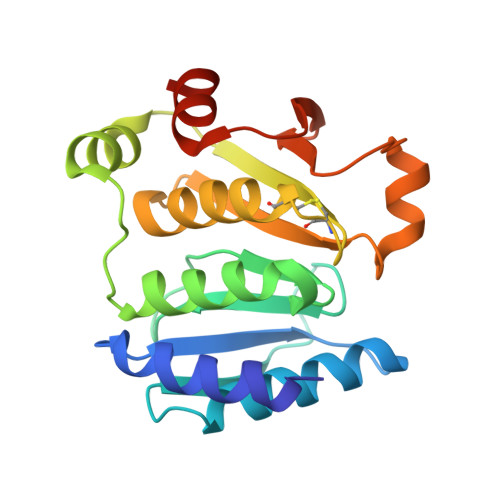Oxidized and synchrotron cleaved structures of the disulfide redox center in the N-terminal domain of Salmonella typhimurium AhpF
Roberts, B.R., Wood, Z.A., Jonsson, T.J., Poole, L.B., Karplus, P.A.(2005) Protein Sci 14: 2414-2420
- PubMed: 16131664
- DOI: https://doi.org/10.1110/ps.051459705
- Primary Citation of Related Structures:
1ZYN, 1ZYP - PubMed Abstract:
The flavoprotein component (AhpF) of Salmonella typhimurium alkyl hydroperoxide reductase contains an N-terminal domain (NTD) with two contiguous thioredoxin folds but only one redox-active disulfide (within the sequence -Cys129-His-Asn-Cys132-). This active site is responsible for mediating the transfer of electrons from the thioredoxin reductase-like segment of AhpF to AhpC, the peroxiredoxin component of the two-protein peroxidase system. The previously reported crystal structure of AhpF possessed a reduced NTD active site, although fully oxidized protein was used for crystallization. To further investigate this active site, we crystallized an isolated recombinant NTD (rNTD); using diffraction data sets collected first at our in-house X-ray source and subsequently at a synchrotron, we showed that the active site disulfide bond (Cys129-Cys132) is oxidized in the native crystals but becomes reduced during synchrotron data collection. The NTD disulfide bond is apparently particularly sensitive to radiation cleavage compared with other protein disulfides. The two data sets provide the first view of an oxidized (disulfide) form of NTD and show that the changes in conformation upon reduction of the disulfide are localized and small. Furthermore, we report the apparent pKa of the active site thiol to be approximately 5.1, a relatively low pKa given its redox potential (approximately 265 mV) compared with most members of the thioredoxin family.
- Department of Biochemistry and Biophysics, Oregon State University, Corvallis, OR 97331-7305, USA.
Organizational Affiliation:
















